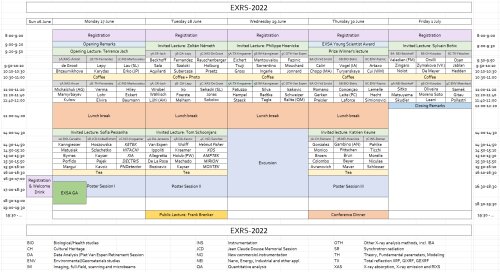The scientific programme of EXRS-2022 consisted of around 10 plenary and invited lectures, contributed lectures as well as three poster sessions.
A considerable number of abstracts (close to 400) was submitted. This substantial number and the wide range of topics addressed, strongly suggested that EXRS-2022 was going to be a very varied and well attended meeting !
In order to ensure that a sufficient number of slots were be available in the oral programme for contributed lectures, we had foreseen that in parallel to the invited lectures and contributed talks given in the main conference hall (A-sessions), presentations were also given in two break-out rooms (B- and C-sessions). The conference therefore consisted of three parallel streams of invited (30 min) and contributed lectures (20 min), three poster sessions and an exhibition of commercially available scientific instruments and associated equipment.
The final time schedule of the meeting is shown below (click the schedule to enlarge).

Invited Plenary Speakers
Sylvain Bohic (INSERM and European Synchrotron Radiation Facility (ESRF), Grenoble, France) "Nano-XRF imaging of trace elements in cells and tissues"

Nanoscopic XRF, as implemented at ESRF Beamline ID16A and equivalent nanoprobes, allows for high resolution mapping of biological tissues and individual cells, down to the level of cell organelles. This opens up many possibilities for studying and optimizing the intracellular behavior of, e.g., new anti-tumor drugs.
Philipp Hoenicke (Physikalisch-Technische Bundesanstalt (PTB), Berlin, Germany) "Dimensional and compositional characterization of nanostructures using the grazing incidence X-ray fluorescence technique"

Grazing-Incidence X-ray fluorescence (GIXRF) analysis is known for in-depth characterization of the elemental composition of stratified nanolayers, shallow dopant profiles. However, when turning to well-ordered 2D & 3D nanostructures, GIXRF also allows to characterize their dimensional properties. An overview of our activities in this direction will be presented, including the more complex calculation of the X-ray standing wave field in these situations.
Terrence Jach (National Institute of Standards and Technology (NIST), Gaithersburg, MD, USA) "High-resolution X-ray emission spectroscopy and the effects of life-time broadening"

High resolution NEXAFS and RIXS spectroscopy of low-Z chemical compounds, combined with up-to-date theory, give us considerable insight into the electronic structure of insulators. We have observed the role of phonon disorder, the behavior of excitons, and anomalous behavior of quasiparticles in a variety of insulating compounds.
Katrien Keune (Rijksmuseum and University of Amsterdam, The Netherlands) "X-ray techniques for investigating artist pigment degradation phenomena and supporting art conservation"

X-ray based methods can be used to gain insights into the spontaneous transformations of artists’ pigments are subject to over time. By combining macroscopic imaging of painted artworks as a whole with microanalysis of paint cross sections using electron microscopes and at synchrotron beamlines, the mechanisms of these (often) unwanted chemical changes can elucidated. This is valuable for art historical interpretation and art conservation.
Zoltan Németh (Wigner Research Centre for Physics, Budapest, Hungary) "High-resolution X-ray absorption and X-ray Emission spectroscopies in the laboratory"

High-resolution X-ray absorption and X-ray Emission spectroscopies are commonly performed at synchrotron facilities but can also be realized by means of laboratory X-ray sources. The pros and cons of these experimental setups will be discussed through several concrete examples.
Sofia Pessanha (Laboratory of Instrumentation, Biomedical Engineering and Radiation Physics (LIBPhys), NOVA School of Science and Technology, Lisbon, Portugal) "Advantages and limitations of portable XRF in environmental and cultural heritage studies"

Portable XRF is a variant of regular EDXRF that is very successful in many areas and has brought a variety of disciplines in contact with X-ray spectrometry and (semi-)quantitative X-ray analysis. The advantages and limitations of P-XRF in different environmental and cultural heritage studies will be outlined.
Tom Schoonjans (Diamond Light Source and The Rosalynd Franklin Institute, Didcot/Oxford, United Kingdom) "Xraylib: capturing the interaction of X-rays with matter"

For 15 years already the Xraylib project has served the X-ray community as a free and open-source software library that provides convenient access to several databases of physical quantities, essential for analyzing and predicting the interactions of X-rays with matter. In release 4.0.0, new features and improvements were introduced, which will be covered during the presentation, along with several examples demonstrating its capabilities.
Public lecture
On Tue evening 28 June, Prof. Frank Brenker discussed "Sample return space missions - Brilliant X-ray studies of asteroidal grains”.
Asteroids are enigmatic objects formed in the early days of our Solar System. They may contain the source of our oceans and the building blocks for life. Some, such as asteroid Bennu will even cross Earth´s orbit at a critical distance. Brilliant X-ray sources around the globe help to decipher the history of this unique material, brought to Earth by JAXA´s Hayabusa2 mission, by studying the content and distribution of trace elements with sub-micron resolution.
This talk took you on a journey to one of the most fascinating adventures in Geoscience!
